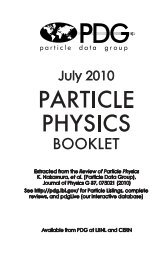30. Passage of particles through matter 1 - Particle Data Group
30. Passage of particles through matter 1 - Particle Data Group
30. Passage of particles through matter 1 - Particle Data Group
Create successful ePaper yourself
Turn your PDF publications into a flip-book with our unique Google optimized e-Paper software.
<strong>30.</strong>6. Muon energy loss at high energy<br />
<strong>30.</strong> <strong>Passage</strong> <strong>of</strong> <strong>particles</strong> <strong>through</strong> <strong>matter</strong> 31<br />
At sufficiently high energies, radiative processes become more important than<br />
ionization for all charged <strong>particles</strong>. For muons and pions in materials such as iron,<br />
this “critical energy” occurs at several hundred GeV. (There is no simple scaling<br />
with particle mass, but for protons the “critical energy” is much, much higher.)<br />
Radiative effects dominate the energy loss <strong>of</strong> energetic muons found in cosmic<br />
rays or produced at the newest accelerators. These processes are characterized by<br />
small cross sections, hard spectra, large energy fluctuations, and the associated<br />
generation <strong>of</strong> electromagnetic and (in the case <strong>of</strong> photonuclear interactions)<br />
hadronic showers [61–69]. As a consequence, at these energies the treatment <strong>of</strong><br />
energy loss as a uniform and continuous process is for many purposes inadequate.<br />
It is convenient to write the average rate <strong>of</strong> muon energy loss as [70]<br />
−dE/dx = a(E) + b(E)E . (<strong>30.</strong>39)<br />
Here a(E) is the ionization energy loss given by Eq. (<strong>30.</strong>4), and b(E) is the sum<br />
<strong>of</strong> e + e − pair production, bremsstrahlung, and photonuclear contributions. To the<br />
approximation that these slowly-varying functions are constant, the mean range<br />
x0 <strong>of</strong> a muon with initial energy E0 is given by<br />
x0 ≈ (1/b)ln(1 + E0/Eµc) , (<strong>30.</strong>40)<br />
where Eµc = a/b. Fig. <strong>30.</strong>22 shows contributions to b(E) for iron. Since<br />
a(E) ≈ 0.002 GeV g −1 cm 2 , b(E)E dominates the energy loss above several<br />
hundred GeV, where b(E) is nearly constant. The rates <strong>of</strong> energy loss for muons<br />
in hydrogen, uranium, and iron are shown in Fig. <strong>30.</strong>23 [5].<br />
The “muon critical energy” Eµc can be defined more exactly as the energy<br />
at which radiative and ionization losses are equal, and can be found by solving<br />
Eµc = a(Eµc)/b(Eµc). This definition corresponds to the solid-line intersection<br />
in Fig. <strong>30.</strong>13, and is different from the Rossi definition we used for electrons. It<br />
serves the same function: below Eµc ionization losses dominate, and above Eµc<br />
radiative effects dominate. The dependence <strong>of</strong> Eµc on atomic number Z is shown<br />
in Fig. <strong>30.</strong>24.<br />
The radiative cross sections are expressed as functions <strong>of</strong> the fractional energy<br />
loss ν. The bremsstrahlung cross section goes roughly as 1/ν over most <strong>of</strong> the<br />
range, while for the pair production case the distribution goes as ν −3 to ν −2<br />
[71]. “Hard” losses are therefore more probable in bremsstrahlung, and in fact<br />
energy losses due to pair production may very nearly be treated as continuous.<br />
The simulated [69] momentum distribution <strong>of</strong> an incident 1 TeV/c muon beam<br />
after it crosses 3 m <strong>of</strong> iron is shown in Fig. <strong>30.</strong>25. The most probable loss is<br />
8 GeV, or 3.4 MeV g −1 cm 2 . The full width at half maximum is 9 GeV/c, or 0.9%.<br />
The radiative tail is almost entirely due to bremsstrahlung, although most <strong>of</strong> the<br />
events in which more than 10% <strong>of</strong> the incident energy lost experienced relatively<br />
hard photonuclear interactions. The latter can exceed detector resolution [72],<br />
June 18, 2012 16:19







